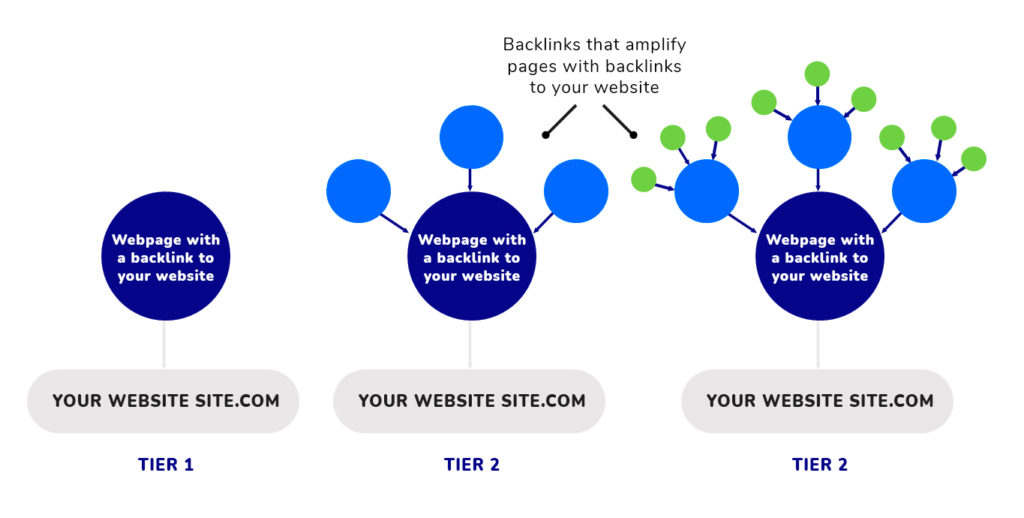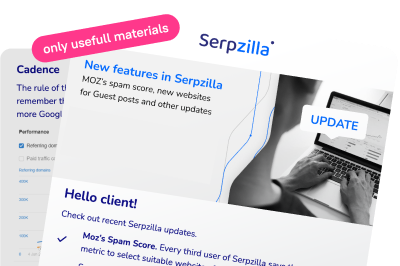Tier 2 and 3 linking is one of the effective strategies for increasing site traffic and improving its search engine positions.
What are Tier 2 and Tier 3 Links
Tiered link building is a method of strengthening a link by placing additional backlinks to it. Known as “multi-level link building” on the internet, this method of enhancing link mass has been around for a decade but remains significantly relevant.
The main idea is to publish backlinks not only to the promoted resource but also to pages that link to it, and to pages that link to those pages.
How does it work? Tier 1 links are those that directly refer to the resource. These can be both natural backlinks and artificially created ones. Tier 2 links lead to pages that have Tier 1 links. Tier 3 links lead to pages with Tier 2 links.

It’s generally best to follow this strategy: the closer a link is to the promoted landing page (Tier 0), the higher its quality should be. Tier 2 often uses Guest Posts backlinks. These backlinks can be purchased through various exchanges like Serpzilla. This is important since the longevity of a link directly affects whether it’s worth investing in or not. With the right approach, Tier 2 links can yield 70-90% of the result.
As for Tier 3, they’re often placed using link-building software. It can create tens of thousands of backlinks per day, as a huge number is needed. Tier 3 links allow for 100% potential utilization, and going further isn’t necessary.
Who Uses Tier 2 and Tier 3 Links and Why SEO SEO-specialists use Tier 2 and 3 link strengthening to achieve certain goals. For example, to boost a site stuck in the top 10 or top 20 for a specific query or to strengthen the link profile when it’s not possible to increase the number of linking domains. This is especially useful if your competitors have few links in the top and you need to maintain naturalness.
Tier 2 and Tier 3 links can be used for promoting any sites without restrictions. They are often used in topics that may be banned in one region but allowed in another, like CBD, specialized pharma, gambling. In such topics, it’s tough to obtain links from other donor domains, so specialists strengthen the current ones.
Second and third-level links are also often used to speed up the indexing of a page if it’s not being indexed: when a page has a link environment, it becomes more valuable to search engines. Sometimes, Tier promotion is the only way to get a resource to the top, especially when the site is fully optimized considering other ranking factors.
How to Promote a Site Using Tier 2 and Tier 3 Links Let’s break down step by step what’s needed to promote a resource using second and third-level links:
- Choose the most interesting query clusters and the landing page you plan to promote. The page can be anything, whether it’s the homepage, an internal category section, or a product/service card.
- Identify donor pages that will lead to the chosen page. Choose pages that have been linking to your resource for a long time and have good behavioral and SEO indicators (monthly traffic, viewing depth, bounce rate, time on site, etc.). You can check such metrics using various analyzer services like Ahrefs or Keys.so. Another important quality metric to consider is visibility in the Google top 50.
- Determine which links and how many you will strengthen with Tier 2 and Tier 3 backlinks. It’s recommended to choose at least 10 links. Otherwise, there might be no effect at all.
- After selecting donors, compile an anchor list of links. Try to use both anchored and non-anchored texts relevant to the donor page or the landing page.
- Start placing links. You can begin with 15-30 backlinks on each donor page. Generate a unique anchor for each link. According to Serpzilla statistics, most SEO-specialists use the following strategy: one unique link for one unique anchor text.
- After placing links, monitor their placement and indexing. Indexing can be determined through special operators in Google’s XML map.
How much do Tier 2 and Tier 3 links cost?
Regarding the budget for Tier 2 and Tier 3 link building, aim for 20-50 dollars within the described concept. This should be enough to strengthen 10-30 donor pages and significantly promote the site in the top for selected queries from the semantic core.
The first results will be noticeable within 1-2 months after the backlinks are indexed. If the site’s positions don’t improve, conduct a detailed audit. Perhaps you’ve made mistakes or something is done incorrectly, like the landing page not being ranked and falling out of the index.
Checklist for Multilevel Link Building
To help you navigate the topic, we’ve compiled a brief checklist. If you want to promote your site using second and third-tier links, here’s what you need to remember:
- Tier-link building is a method of strengthening a link by placing additional backlinks on it: Tier 1 links directly reference your resource; Tier 2 lead to pages with Tier 1 links; Tier 3 lead to pages with Tier 2 links.
- Second and third-tier links strengthen the link profile of a resource, as a well-promoted external page leading to your site can be more beneficial than an additional backlink.
- To promote a site using Tier 2 and Tier 3 links, you need to select queries, the landing page to be promoted, donor pages, links you plan to strengthen, and compile an anchor list of links. After this, you can start placing backlinks. The key is to keep track of their placement and indexing.
- To strengthen 10-30 donor pages, a budget of 20-50 dollars will be sufficient. The first results of the promotion will be noticeable within the first month after the backlinks are indexed.
With the right approach, you can not only increase traffic to your site and improve its positions in search results but also attract an interested audience. The main thing is to increase the link mass gradually and ensure that the theme of the material is relevant to the theme of the promoted resource, and ideally to the donor page. In this case, you will achieve the maximum effect from promoting with second and third-tier links.



